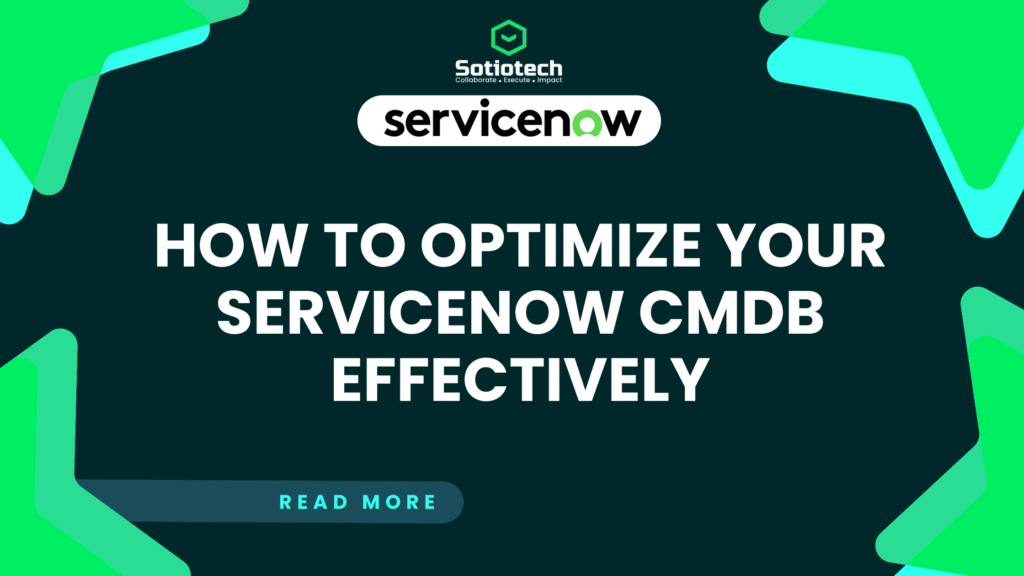CMDB:
Configuration management database (CMDB) is a database that contains information about the elements in an organization’s IT environment called the configuration items or CIs and how they are related. This database is a powerful instrument for IT service management that can help organizations to achieve their goals in the sphere of effective IT assets management.
Key Aspects of CMDB:
Configuration Items (CIs): These are the IT objects that are individual to the IT environment, information like servers, applications, network devices, documentation etc.
Relationships: CI in the CMDB also maintains information about the relationships between these CIs, including how these components are related and usually rely on each other.
Data Accuracy: The CMDB needs to constantly and correctly reflect real conditions to provide adequate support for IT management and decision making.

Introduction to CMDB:
The Configuration Management Database (CMDB) application also lets you construct logical configurations of the assets, services, and interconnections that constitute the infrastructure of your organization. About these components details are kept in the CMDB which you can use to manage the infrastructure and guarantee its integrability, stability and readiness to operate continuously. Monitor health issues with CMDB Health, identify and address data integrity problems with CMDB Identification & Reconciliation, and manage data life cycle with CMDB CI Lifecycle Management.
The tables of the CMDB include the following:
The Base Configuration Item [cmdb] table that is the primary table in the CMDB for all CIs that are not Information Technology. The cmdb_ci core table that has information on the fundamental parameter of all the CIs. This table can only be accessed if the user has any of the three roles, the admin, itil or the asset user role. CI Relationship [cmdb_rel_ci] table which defines all relationship of CIs.
The Configuration Item table is related to other tables, as Database [cmdb_ci_database] and Computer [cmdb_ci_computer]. Computer table has a foreign key added to Server [cmdb_ci_server] table which is linked to UNIX Server [cmdb_ci_unix_server] table and goes on.
You can use the schema map to view more details of tables and their relationships:
Go to System Definition > Tables & Columns. From a selected table, choose Schema Map.
Add a CI class (table) derived from an existing CI class. After that, it is necessary to establish identification and reconciliation rules for the new class.
- Navigate to Configuration > CI Class Manager.
- Click Hierarchy to expand the CI Classes list. Then select the class that the new class is extended from.
- Click Add Child Class.
The Add Child Class option appears only if the selected class is extendable.
- On the Provide Basic Info tab, fill out the information and then click Next.
- On the Add Attributes tab, click the + sign and enter details for each new class column. Then click Next. For description of the different columns in the list view. Set Identification to true to designate the column as a CI identifier for class identification.
- On the Set Identification Rule tab, examine the Derived identification rule and its Identifier Entries. You can click Replace to replace the derived rule with a new identification rule and new identifier entries specific to the new class.
- On the Dependencies tab, click Add dependency to add dependent rules.
The Dependencies tab appears only if there are dependent identification rules for the selected class.
- On the Add Reconciliation Rules tab, click Add to create the following rules:
Reconciliation Rules
Data Precedence Rules
Data Refresh Rules
On the Add Suggested Relationships tab, review the diagram of the class derived suggested relationships. Use the filter to display only inbound, outbound, or specific relationship types. To add a suggested relationship for the class:
- Click New
- In the Add Suggested Relationship dialog box, select a Relationship and a Target Class for the relationship. This Class and the Target Class become parent or child in the suggested relationship, based on your selection of the Relationship.
- Click Save.
When building relationships for the class in the Query Builder, the list of suggested relationships is updated.
- Click Done.
CMDB schema model:
The Configuration Management Database (CMDB) schema model is a set of linked tables containing every asset or business service managed by a firm and their configurations.
These are records about computers and devices in the network, software vendors and licenses, business services, and the like. The IT desk can see network users equipment and their connections while the functional IT desk can use it as a means of understanding their user requirements. Other processes can also use the CMDB itself within the actual system.
The CMDB can be filled using the Discovery product. Discovery scans the network for all the connected computers and devices and adds related information about those computers and devices into the CMDB, including their configuration, provisioning, and their status. Discovery also reports on any software that is running and the TCP connections between two or more computer systems thus establishing the connection.
Applications like Asset Management and Contract Management run parallel to the CMDB. Each type of Asset Management, Software, organizational assets in store and Records from manufacturers and vendors link into the CMDB. Contract Management application holds the record of all contracts whether it is leases, service contracts, purchase orders, warranties, or software licenses. The Configuration Management application has an operation orientation.

What is ServiceNow CMDB:
The Configuration Management Database or CMDB in ServiceNow basically functions as a single source of truth with regards to your organization’s IT landscape. Carrying a primary role of a data warehouse, it also encompasses information about IT assets and business services and their details.
Key Features of ServiceNow CMDB:
Comprehensive Data Warehouse: The CMDB being a single point of reference for any configuration item (CI) data helps in sharing accurate data with the enterprise.
Enhanced IT Service Management (ITSM): Due to the timeline and detailed view of infrastructure and services, the CMDB facilitates and improves the ITSM to support other processes.
Integration Capabilities: The CMDB can work with other ServiceNow modules and with external applications to provide more unified approach in ITOM tasks.
Benefits of Implementing ServiceNow CMDB:
Improved Visibility: The important aspect of visual representation simplifies the understanding of the IT environment and the organization of assets and services connected with it.
Operational Efficiency: In this way, the CMDB provides beneficial inputs to improve organizational operations by preventing the occurrence of issues and providing correct information to bring solutions on time.
Support for ITSM Processes: The IT asset management and the relationship map for the configuration items support different ITSM processes such as incident, problem, and change.

Capabilities of CMDB:
Centralized Data Repository: Stored data includes all information that is required to maintain an accurate representation of the IT environment and refers to the Configuration Management Database.
Automated Discovery: It has also incorporated discovery tools which are used to discover new CIs as they are deployed in IT, hence updating the ServiceNow CMDB.
Relationship Mapping: It provides dependency between the IT assets, the application of an organization and the services, thereby enabling an organization to know how different components are related and how they affect other elements.
Change Management Support: The CMDB plays an important role in identifying the effect on other CIs in case of change, thus enabling controlled and predictable change to the IT environment.
Reporting and Analytics: It provides powerful reporting and analytics tools, with which an organization can get real insights into its IT environment, and detect trends for appropriate action.
Integration with ITSM Processes: The CMDB is also synchronised with the rest of the ServiceNow modules inclined to service management such as the IT Service Management (ITSM) encompassing the incident, problem, and change management.
CMDB query builder:
Cross-Class Queries: Create queries that are extended across various CMDB classes so that you get more details from the data base.
Non-CMDB Table Integration: Use information taken from non-CMDB tables that is linked to the CMDB classes creating a comprehensive infrastructure view.
Relationship Mapping: Visualize and analyse the existence and connection between different CIs with an aim of facilitating impact analysis as well as decision making.
Reporting and Scheduling: Email the results of queries in reports and set up recurring reports to automatically save time.
Accessing the CMDB Query Builder:
To access the CMDB Query Builder:
- Navigate to the Application Navigator in ServiceNow.
- Type “CMDB Query Builder” into the search bar.
- Click on “Create New” to start building a new query.
Creating a Query:
Within the CMDB Query Builder:
- Select the primary table (e.g., cmdb_ci_computer) to serve as the starting point for your query.
- Use the “Add Relationship” feature to include related tables, such as cmdb_ci_service or cmdb_ci_database.
- Define the conditions for each table to filter the data as needed.
- Utilize the “Preview” function to view the query results before saving.
- Save the query for future use or scheduling

CMDB Dashboards and Workspace in ServiceNow:
Configuration Management Database (CMDB) is the fundamental to IT Service Management (ITSM) and gives important information on the IT framework. CMDB utility with ServiceNow is improved with the help of Dashboards and Workspaces since they provide additional views and tangible interfaces. Here is a detailed exploration of CMDB Dashboards and Workspace, broken down into four major sub-topics:
1.Overview of CMDB Dashboards
CMDB Dashboards are graphical representations of different data published in the CMDB that can be manipulated by the user. These dashboards therefore help the IT groups to display, control and improve their IT setting effectively.
Key Features:
- Pre-built Dashboards: Basic ServiceNow dashboards are available such as, CMDB Health Dashboard, Relationship Dashboard, Change Impact Dashboard, etc.
- Customizable Widgets: There are specific widgets available that show only CI health, compliance, and changes.
- Real-time Updates: Dashboards update themselves as more modifications are done on the CMDB.
Benefits:
- Improved Visibility: It is easy for teams to be able to view at a glance the status and performance of various CIs.
- Faster Decision-Making: Stakeholders can gain observations of problems and act on them immediately.
- Enhanced Compliance: Key function management dashboards reflect compliance to standards, for example, on data quality and comprehensiveness.
2. CMDB Health Dashboards
Health dashboards are about the credibility, sufficiency, and standard of any CMDB, to guarantee that the database stays accurate for any given choices.
Key Components:
- Data Completeness: Records whether all required fields in CI records are filled.
- Data Accuracy: Checks that the gathered CI data correspond to actual configurations.
- Compliance Scores: Responsible for the evaluation of the extent or compliance with the governance policies.
3.CMDB Workspace
The CMDB Workspace is a unique workplace specially to simplify CI handling and present a limited but efficient working place for administrators and analysts.
Features and Capabilities:
- Unified View: Provides all CI details from relationships, dependencies to record history all in one place.
- Relationship Mapping: Interactive maps focus on the relationships that CIs have an impact analysis is facilitated.
- Task Integration: Integrates CI information with incidents, changes, and problems for continuous and effective carrying out of tasks.
- Real-time Monitoring: Using the alerts and notifications, administrators can attend to important incidents in good time.
Advantages:
- Improved Productivity: Reduces the time to identify and analyze the CI information.
- Enhanced Collaboration: Is used to accommodate cross functional teams for working on CI related problems.
4. Customizing Dashboards and Workspaces
A customized dash-board and workspace for the management of school documentation has been developed. Dashboard and workspace can be configured and this make it possible for dashboards and workspaces to be adjusted to fit particular needs that an organization has, and the goals of the IT department.
Customization Options:
- Widgets: Take into consideration to create own widgets with own rates like SLA, change approval or CI’s lifecycle.
- Filters and Views: Use the freedom to filter CIs by the selected CI categories or groups, for example, by servers, applications, network devices, etc.
- Third-party Data Integration: Intern data sources reviewed for a comprehensive perspective.
Steps to Customize:
- Identify Requirements: Identify what measures and information regarding sales performance is useful to various stakeholders.
- Reporting Tools: Reporting or Performance Analytics can be utilized to build up unique widgets on ServiceNow.
- Test and Refine: Approve fields and modify them according to feedbacks received.


Thank you for taking the time to read our content! We appreciate your interest in SotioTech and look forward to helping you achieve your IT service management goals with our ServiceNow solutions. If you have any questions or need assistance, feel free to reach out to us through our page www.sotiotech.com and our pages. Stay connected with us on LinkedIn for the latest update.





